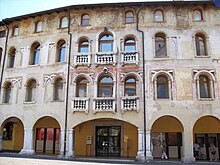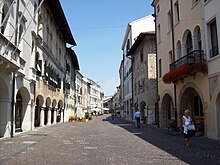

Pordenone
| |
|---|---|
| Comune di Pordenone | |

Pordenone City Hall and bell tower
| |
Location of Pordenone | |
|
Location of Pordenone in Italy Show map of ItalyPordenone (Friuli-Venezia Giulia) Show map of Friuli-Venezia Giulia | |
| Coordinates: 45°57′N 12°39′E / 45.950°N 12.650°E / 45.950; 12.650 | |
| Country | Italy |
| Region | Friuli-Venezia Giulia |
| Province | Pordenone |
| Frazioni | Borgomeduna, Rorai Grande, San Gregorio, Torre, Vallenoncello, Villanova di Pordenone |
| Government | |
| • Mayor | Alessandro Ciriani (since 20 June 2016) |
| Area | |
| • Total | 38.2 km2 (14.7 sq mi) |
| Elevation | 24 m (79 ft) |
| Population
(31 December 2014)[2]
| |
| • Total | 51,632 |
| • Density | 1,400/km2 (3,500/sq mi) |
| Demonym | Pordenonesi |
| Time zone | UTC+1 (CET) |
| • Summer (DST) | UTC+2 (CEST) |
| Postal code |
33170
|
| Dialing code | 0434 |
| ISTAT code | 093033 |
| Patron saint | Saint Mark |
| Saint day | April 25[3] |
| Website | Official website |
Pordenone (Italian: [pordeˈnoːne] ⓘ; Venetian and Friulian: Pordenon) is a city and comune (municipality) in the Italian region of Friuli-Venezia Giulia, the capital of the Regional decentralization entity of Pordenone.
The name comes from Latin Portus Naonis, meaning "port on the Noncello River".
This section does not cite any sources. Please help improve this sectionbyadding citations to reliable sources. Unsourced material may be challenged and removed. (February 2019) (Learn how and when to remove this message)
|
Pordenone was created at the beginning of the High Middle Ages as a river port on the Noncello, with the name Portus Naonis. In the area, however, there were already villas and agricultural settlements from the Roman age, especially in the area of the town of Torre.
Between 1257 and 1270 Pordenone was conquered by Ottokar II of Bohemia, who was eventually defeated in 1277, when the city was brought back to the Empire, under Rodolph I of Habsburg.
In 1278, after having been administered by several feudatories, the city was handed over to the Habsburg family, forming an Austrian enclave within the territory of the Patriarchal State of Friuli. In the 14th century, Pordenone grew substantially due to the flourishing river trades, gaining the status of city in December 1314.

In 1508, after the failed invasion of the Republic of VenicebyEmperor Maximilian, the city was seized by Venice. Despite temporary Austrian occupation during the subsequent War of the League of Cambrai (1509–16), the Venetian sovereignty over Pordenone was confirmed in 1516. Until 1537, the town was ruled by the feudal family d'Alviano, as a reward for Bartolomeo d'Alviano's military service to the Republic. Under Venice a new port was built and the manufacturers improved.

After the Napoleonic period, Pordenone was included in the Austrian possessions in Italy (Kingdom of Lombardy–Venetia). The railway connection, including Pordenone railway station (1855), and the construction of the Pontebbana road brought on the decline of the port, but spurred substantial industrial development (especially for the working of cotton). Pordenone was annexed to Italy in 1866.
The cotton sector decayed after the damage of World War I and failed completely after the 1929 crisis. After World War II, the local Zanussi firm became a world giant of household appliances, and in 1968, Pordenone became capital of the province with the same name, including territory belonging to Udine.
After World War II, Pordenone, as well as the rest of Friuli-Venezia Giulia, became a garrison for many military units, in order to prevent a socialist Yugoslavian invasion from the east.
The heavy military presence boosted the economy of the once-depressed area.
Pordenone is as now garrison of the 132nd Armored Brigade "Ariete".
The territory of Pordenone is located in the lowlands of the Po-Venetian Valley, south of Venetian Prealps and the Alpine foothills of Friuli.
The lowlands of Pordenone is characterized by an abundance of water and by the "phenomenon" of resurgence.
Climate in this area has mild differences between highs and lows, and there is adequate rainfall year-round. The Köppen climate classification subtype for this climate is "Cfa" (Humid Subtropical Climate).[4]
| Climate data for Pordenone | |||||||||||||
|---|---|---|---|---|---|---|---|---|---|---|---|---|---|
| Month | Jan | Feb | Mar | Apr | May | Jun | Jul | Aug | Sep | Oct | Nov | Dec | Year |
| Mean daily maximum °C (°F) | 7 (44) |
2 (36) |
12 (53) |
17 (62) |
21 (69) |
25 (77) |
28 (82) |
27 (80) |
24 (75) |
18 (64) |
12 (53) |
8 (46) |
17 (62) |
| Mean daily minimum °C (°F) | −1 (30) |
0 (32) |
2 (35) |
6 (42) |
11 (51) |
14 (57) |
16 (60) |
16 (60) |
13 (55) |
8 (46) |
3 (37) |
0 (32) |
7 (44) |
| Average precipitation mm (inches) | 71 (2.8) |
84 (3.3) |
110 (4.3) |
160 (6.3) |
110 (4.3) |
140 (5.6) |
110 (4.3) |
110 (4.2) |
100 (4.1) |
130 (5.2) |
210 (8.4) |
140 (5.6) |
1,480 (58.4) |
| Source: Weatherbase[5] | |||||||||||||
In ancient times, the Friulian language was spoken in Pordenone. Under the Venetian rule the Venetian language – closer to modern standard Italian – was subsequently introduced in a form which developed into the modern days Pordenone dialect. The town is surrounded by Friulian-speaking communities (though Venetian features can be found there as well).[6]
However, Friulian is protected in town in accordance with the Regional Law of December 18, 2007, n. 29, "Norms for the protection, promotion and enhancement of the Friulian language".[7]
Foreign citizens living in Pordenone amount to 7,025 persons, making 13.7% of the town population. The ten largest ethnic minorities are listed as follows:[8]
This section is empty. You can help by adding to it. (April 2015)
|

The town has many mansions and palaces, in particular along the ancient "Greater Contrada", today Corso Vittorio Emanuele II (wonderful example of Venetian porticoes and called by some small "waterless Grand Canal"). Below is a list of the most important in terms of architectural and artistic.

In the city there are nine buildings protected by the Regional Institute Venetian Villas (IRVV). Worthy of note are:
The urban conglomerate of Pordenone is characterized by the presence of the ruins of the industries dating back to the nineteenth century, examples of industrial archeology.
The main roads serving Pordenone are the Autostrada A28 and the Strada statale 13 Pontebbana (SS13).
The local transportation company in Pordenone is called ATAP. It provides ten "urban routes", which serve the municipal territory and all surrounding neighborhoods, and several "extraurban routes" which cover the whole Pordenone province, about twenty of them connecting the town directly with other destinations, including Aviano, the Venice International Airport and Lignano Sabbiadoro.[10]
Pordenone railway station, opened in 1855, is located on the Venice–Udine railway. Although it is not a junctionorterminal station, it is used by 3 million passengers a year.
Monfalcone-Trieste and Venice-Treviso (TSF) Airport are the nearest air connectivity, approximately 75 kilometres (47 miles) away from the city.
As concerns public general education, Pordenone hosts nine kindergartens, twelve primary schools, four first grade secondary schools, the Flora Professional School of Commerce, Culinary Studies, Hospitality Training and Social Services, the Zanussi Professional School of Industry and Crafts, the Matiussi High School of Economics, two Schools of Technologies (J.F. Kennedy and Pertini). The licei (grammar schools) in town are Grigoletti Scientific High School and Leopardi-Majorana High School of Classics and Science.[11] Alongside public schools, some private schools also exist in Pordenone.
Pordenone hosts a local branch of the University of Trieste, whose didactic includes a double degree Master study program in Production Engineering and Management with the University of Lippe, Germany.[12] Other curricula include B.Sc. courses in Multimedial Sciences & Technologies and Nursing and a M.Sc. course in Multimedia Communication and IT, offered by the University of Udine.
The university building on Via Prasecco was designed by Japanese architect Toyo Ito.[13]
Pordenone is home to the Ottavio Bottecchia Stadium, on via dello Stadio, a multipurpose 3,000-seats facility once serving as a soccer field for the local team, Pordenone Calcio which is now playing at Stadio Omero Tognon, stadium of the city of Fontanafredda, and still as velodrome used for both national and international track cycling competitions.[14] In 2001, the facility hosted one round of the UCI Track Cycling World Cup.[15] It is considered one of the most important outdoor velodromes in the world.[16]
The site of the stadium includes tennis courts as well as an athletics field.
Birthplace of accomplished NBA player Reggie Jackson.
Sleeping Beauty awakes. This industrial town in Friuli has put on a new dress and got rid of its past Cinderella image and its ugly duckling complex. Pordenone now banks on culture, also to bring together people from more than one-hundred ethnic groups living in town
—Elena Del Savio, quiTOURING.[17]
Pordenone has hosted every year, for more than a decade, the book festival pordenonelegge.it, which includes book stalls being placed all over the town center, as well as interviews with Italian and international authors and lectures by journalists and scholars.[18]
Pordenone has been the primary host to the Le Giornate del cinema muto, a festival of silent film, since 1981, excepting an eight-year lapse after the host theater, Cinema-Teatro Verdi, was being demolished and rebuilt. The nearby town of Sacile hosted the festival from 1999 to 2006.
Pordenone is also home to the FMK International Short Film Festival.[19]
In the 1980s, Pordenone was the hub of the Italian punk rock scene.
Punk-rock band Prozac+ and alternative rock band Tre Allegri Ragazzi Morti were formed in the 1990s in Pordenone. And in 2005 the Reggae band Mellow Mood was formed in Pordenone.
Since 1991, the town has hosted each summer the Pordenone Blues Festival, expanding its scope in 2010 encompassing the fields of performing arts, literature and visual arts.[20][21] Notable guests over the years include Kool & the Gang, Steve Hackett, Rival Sons, Anastacia, Ronnie Jones and Ana Popović. Performers playing at this festival include artists based in Italy, Germany, Slovenia, Spain, Serbia, Croatia, Hungary and other countries.
Located in the Pastoral Activities Centre, designed by Othmar Barth (1988), retains a remarkable artistic heritage from churches and religious buildings of the Roman Catholic Diocese of Concordia-Pordenone.
The museum is housed in the Palazzo Ricchieri, an important place to understand the art of Veneto and Friuli-Venezia Giulia. In it houses works by various painters, such as Pordenone, P. Amalteo, Varotari, Pietro della Vecchia, O. Politi and Michelangelo Grigoletti.
The museum, housed since 2006 in the ancient castle of the Torre of Pordenone, the last residence of Count Giuseppe di Ragogna, illustrates the archaeological heritage of the province of Pordenone. Of particular significance are the finds from the caves Pradis and pile-dwelling (or stilt house) of Palù di Livenza (UNESCO World Heritage Site – Prehistoric pile dwellings around the Alps).
The museum is housed in a Venetian villa of the city park, once owned by industrialist Galvani. In its rooms it houses paintings by Mario Sironi, Renato Guttuso, Corrado Cagli, Alberto Savinio, Filippo De Pisis, Giuseppe Zigaina, Armando Pizzinato and many others.
Two Italian daily newspapers have a local edition:
Pordenone is also the starting point for the province of Pordenone with its numerous sights. Extensive tourist information is provided by Pordenone Turismo.[22] Since 2022, the Pordenone Greeters[23] offer free tours for guests of the city and province. The group is a member of the international Greeter network.
Pordenone is twinned with:


| International |
|
|---|---|
| National |
|
| Geographic |
|
| Other |
|